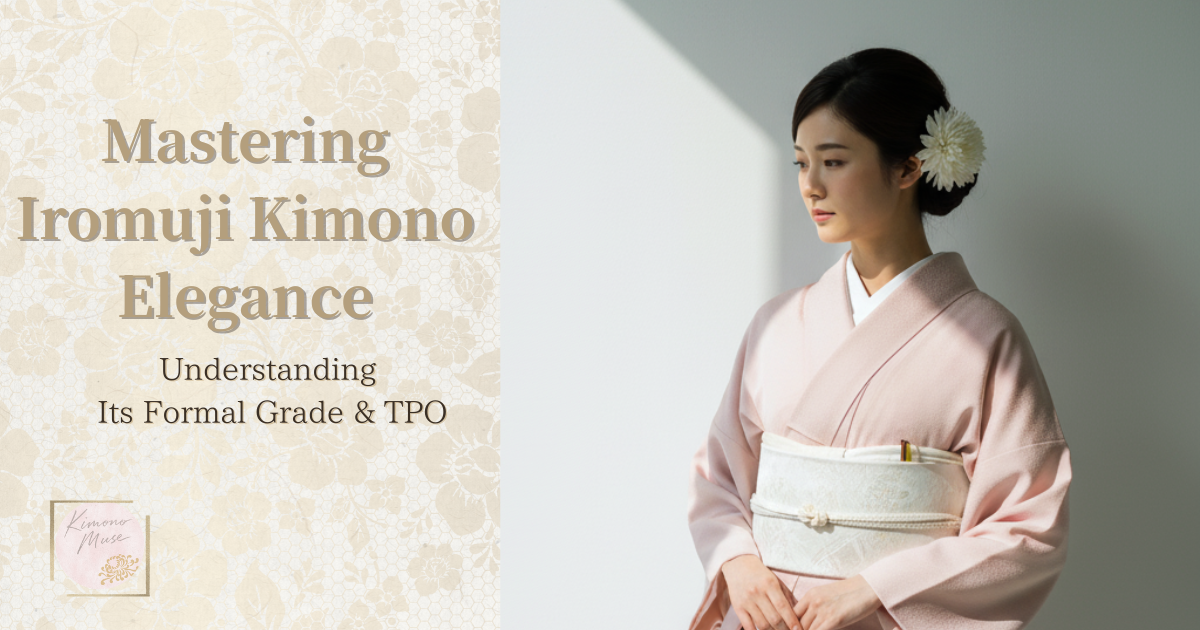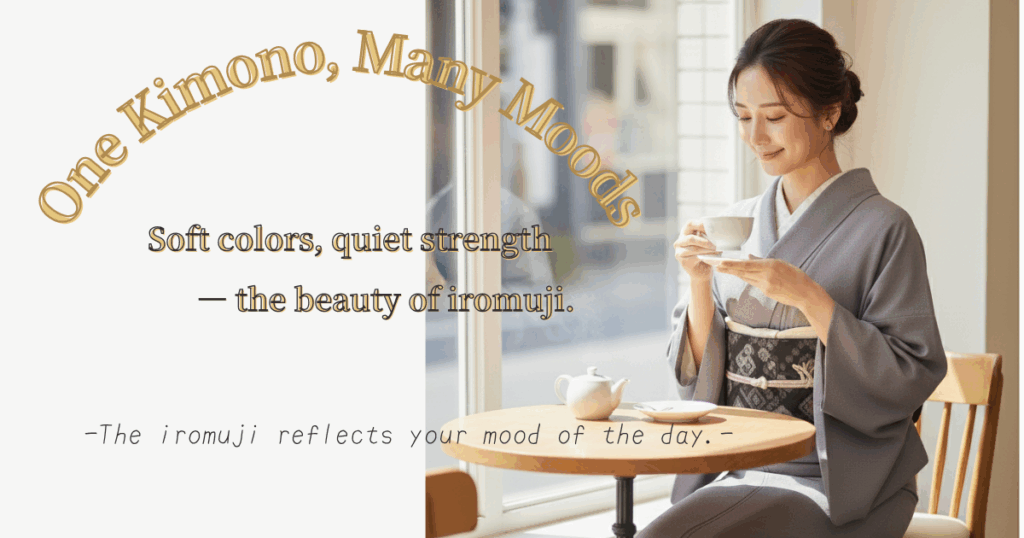In Japan, there are many life events where wearing a kimono feels especially meaningful—
a child’s school entrance ceremony, a friend’s wedding, or a traditional celebration such as Shichi-Go-San,
a festival where children aged three, five, and seven are dressed in kimono to pray for healthy growth.
If you ask someone familiar with kimono culture, you’ll often hear,
“An iromuji kimono is the one piece every woman should have.”
Still, you might wonder:
“Can a plain kimono with no patterns really be appropriate for formal occasions?”
“Won’t it look too modest?”
In Japan, the iromuji is considered a uniquely versatile kimono—
its level of formality changes dramatically depending on whether it bears a family crest (mon) or not.
It can be worn to a wide range of occasions:
from weddings and graduation ceremonies to tea gatherings and other cultural events.
This guide explains what an iromuji is, how crests determine its formality,
and how to choose colors that remain timeless and elegant through the years.
By the end, you’ll see why in Japan, the iromuji is called “the most versatile kimono.”
It’s a single garment that gracefully fits every stage of life.
- What Is an Iromuji Kimono?
- The Most Important Element That Defines Formality: the Family Crest (Mon)
- Formality, Occasions, and Styling Rules — by Number of Crests
- One Kimono, Many Transformations — Styling the Versatile Iromuji
- Practical Guide — How to Choose Your First Iromuji Without Regret
- Iromuji Q&A — Answering the “Whys” Behind Kimono Etiquette
- Final Thoughts: The Iromuji — A Timeless Companion When You Know Its Formality and TPO
What Is an Iromuji Kimono?
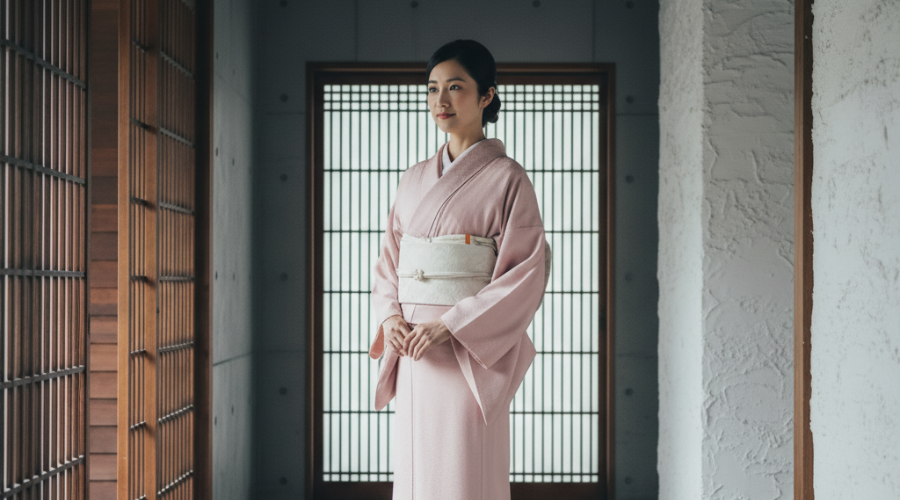
Before diving deeper, let’s first look at what exactly an iromuji kimono is.
Understanding how it differs from other styles—such as the homongi, known for its elegant patterns, or the komon, a casual kimono covered in small repeating designs—
will help you see why the iromuji is often praised as “the most versatile kimono” in Japan.
If you’d like to understand how kimono are classified by formality and TPO in Japan, you can read our companion article:
Kimono TPO and Formality Levels Explained — What’s the Difference Between Formal and Casual?
A Kimono Dyed in a Single Color — Except Black
An iromuji is, as its name suggests, a kimono dyed in a single color other than black, with no decorative patterns.
Because of its one-color dyeing, it gives a clean, understated, and elegant impression.
You might wonder, “Won’t it look too plain without any patterns?”
But in fact, that very simplicity is what makes the iromuji so special.
It embodies the Japanese aesthetic of beauty found in restraint — a quiet grace that leaves room for the wearer’s personality to shine through.
Depending on how you coordinate it — with a formal obi and accessories for ceremonial occasions, or with lighter styles for casual outings —
the iromuji can adapt beautifully to a surprisingly wide range of scenes.
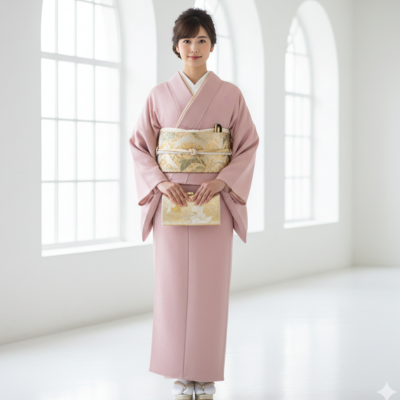
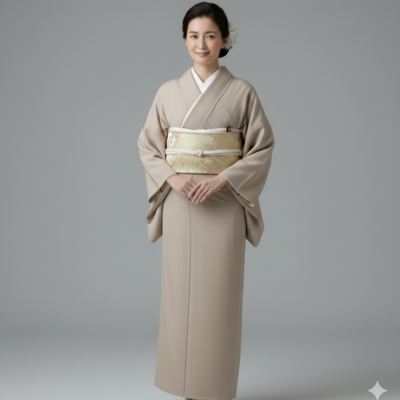
How Jimon (Woven Patterns) Affect the Look and Formality
Earlier, we described the iromuji as a “kimono with no patterns.”
However, some iromuji actually feature delicate woven designs, known as jimon.
A jimon is a pattern created within the weave of the fabric itself, rather than being printed or embroidered on the surface.
Even when dyed in a single color, these subtle designs appear to shimmer gently as light moves across the fabric or as the angle changes.
This quiet interplay of light and texture gives the otherwise plain iromuji a sense of depth and graceful sophistication —
a beauty that reveals itself only to those who take a closer look.
How Does Having (or Not Having) Jimon Change Its Impression?
| Type | Fabric Characteristics | Impression & Use | Typical Occasions |
|---|---|---|---|
| With Jimon (e.g., rinzu satin weave) | Glossy fabric with woven patterns that subtly emerge in the light. Often features auspicious motifs such as pine, bamboo, plum blossoms, cranes, or tortoiseshell designs, as well as classic patterns like shippō (seven treasures) and karakusa (arabesque). | Elegant and graceful. Suitable for formal or celebratory occasions. | Children’s school entrance or graduation ceremonies, weddings, and other joyful events. |
| Without Jimon (e.g., habutae plain weave) | Matte fabric with a calm, refined texture. Either completely smooth or woven with an extremely fine structure. | Quiet and understated. Ideal for semi-formal or casual wear; highly versatile for both formal and informal settings. | Everyday outings, memorial services, tea gatherings, and a wide range of situations. |
When dressing for a child’s special occasion — such as a school entrance ceremony —
it’s best to choose an iromuji made from fabric with woven auspicious patterns,
known in Japan as kisshō monyō.
These celebratory motifs, like pine, bamboo, plum blossoms, or cranes,
are believed to bring good fortune and create an elegant impression that suits joyful family events.
Why the Iromuji Is Considered Formal Attire
You might wonder, “Why is a kimono with no patterns considered formal wear for events like entrance ceremonies?”
In Japan, plain-colored kimono have long been regarded as formal attire.
Historically, before the Meiji era (late 19th century), both at the imperial court and within samurai society,
unpatterned kimono symbolized dignity, purity, and respect.
Even in the early modern period, female students wore plain kimono for their graduation ceremonies —
a tradition that reflected the idea that simplicity conveys refinement.
Because of this cultural heritage, the iromuji remains recognized today as a formal or semi-formal kimono when adorned with a family crest (mon).
The absence of patterns does not mean a lack of formality —
it expresses a quiet elegance rooted in centuries of Japanese tradition.
The Most Important Element That Defines Formality: the Family Crest (Mon)
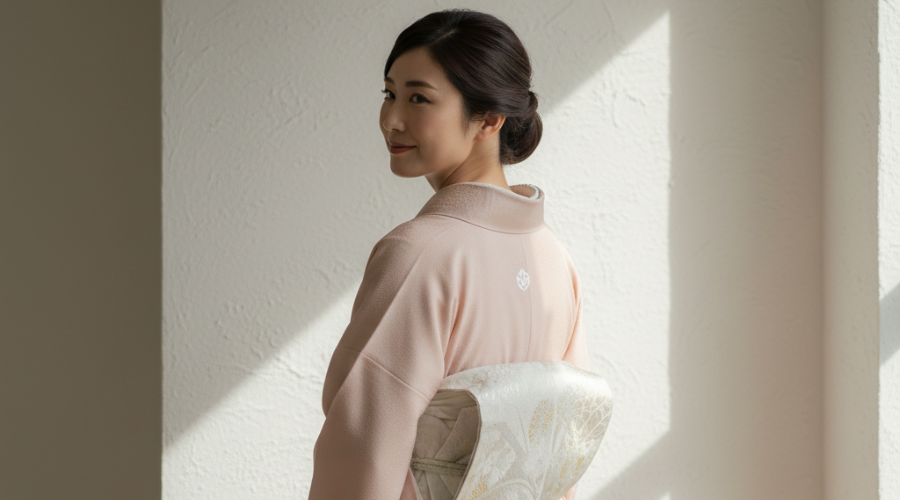
The main reason why the iromuji is often called “the most versatile kimono” lies in this single detail — the family crest, or mon.
At the same time, it is also the most important — and most misunderstood — element when choosing an iromuji.
You might wonder:
“I often hear about the ‘mon,’ but what exactly is it?”
“Do I really need one for my child’s school entrance ceremony?”
These are the very questions that many kimono beginners struggle with.
In fact, the number of mon you place on an iromuji — or whether you include any at all —
dramatically changes its level of formality and the kinds of occasions where it can be appropriately worn.
What Is a Mon (Family Crest)?
A mon refers to the family crest that is placed on a kimono — usually on the back, sleeves, or chest.
The process of adding these crests is called mon-ire (literally “adding a crest”),
and a kimono that bears one or more crests is known as a montsuki.
There are several traditional techniques for applying a mon,
such as hand-painting, dye-resist methods, or embroidery,
and the technique itself can influence the kimono’s level of formality.
| Type | Technique & Characteristics | Formality & Impression | Typical Use / TPO |
|---|---|---|---|
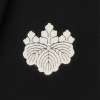 Dyed Crest (Some-nuki Mon) Dyed Crest (Some-nuki Mon) | The design is created by resist-dyeing the background, leaving the crest area white. Considered the most formal technique. | Highest level of formality. | Formal ceremonial attire such as kurotomesode or mourning kimono. |
 Hinata Mon Hinata Mon | Both the outline and the inside of the crest are resist-dyed in white. | Extremely formal, equal to the some-nuki mon. | Worn for formal or ceremonial kimono like kurotomesode and mourning wear. |
 Kage Mon Kage Mon | Only the outline of the crest is resist-dyed in white, leaving the inside in the kimono’s color. | Slightly less formal and more subdued than the hinata mon; refined and elegant. | Suitable for semi-formal or less formal ceremonial occasions. |
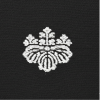 Embroidered Crest (Nui Mon) Embroidered Crest (Nui Mon) | The crest is represented through embroidery instead of dyeing. | Less formal than the dyed crest; slightly more casual and decorative. | Common on fashionable kimono, houmongi, and iromuji for stylish occasions. |
When tailoring an iromuji for semi-formal occasions — such as a friend’s wedding or a child’s school ceremony —
using the most formal some-nuki hinata mon (a fully white-dyed crest) can sometimes feel a little too solemn.
In such cases, many people choose a more understated some-nuki kage mon,
where only the outline of the crest is dyed, or an even softer impression with an embroidered crest (nui mon),
which lowers the formality while still maintaining elegance.
This thoughtful balance — expressing respect without appearing overly formal —
is one of the subtle arts of dressing in kimono.
How the Number of Crests Determines Formality and TPO
This is the key point when it comes to iromuji kimono.
The number of family crests (mon) dramatically changes the kimono’s level of formality.
- More crests → higher formality
- No crest → more casual
This is the golden rule of the iromuji.
For example, even if two iromuji are the same soft pink color,
a kimono with five crests is considered the highest level of formal wear — suitable for occasions such as a relative’s wedding —
while one without any crests would be treated as everyday or fashionable attire.
For semi-formal occasions such as school entrance or graduation ceremonies, Shichi-Go-San celebrations, or a friend’s wedding,
having at least one crest is generally recommended.
So how exactly does the number of crests affect formality and TPO?
Let’s take a closer look in the next section.
Formality, Occasions, and Styling Rules — by Number of Crests
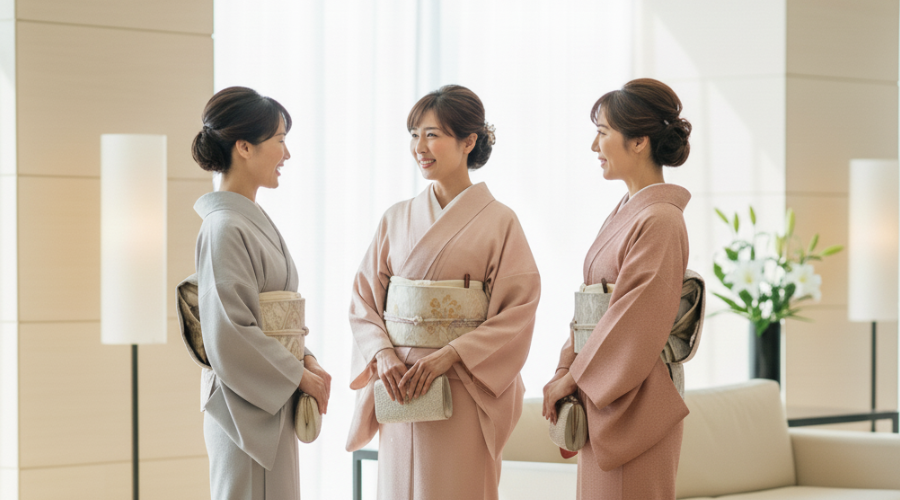
The iromuji is divided into four categories based on the number of crests (mon) it bears:
five crests, three crests, one crest, and no crest.
Each represents a distinct level of formality and corresponds to specific occasions (TPO).
Let’s look at them in order — from the most formal to the most casual —
to find which type best suits your purpose and lifestyle.
Five Crests (Itsutsu-mon)
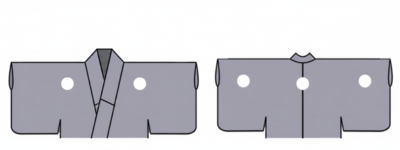
| Category | Details |
|---|---|
| Placement of Crests | Five in total: one on the center back, two on the chest, and two on the outer sleeves. |
| Formality Level | Most formal attire (First-level formal wear) — equivalent in rank to kurotomesode or irotomesode. |
| TPO (Appropriate Occasions) | Worn for the highest-level formal events, such as weddings or receptions where you are part of the hosting family (parents or close relatives of the bride or groom), or for ceremonial and religious functions requiring utmost formality. |
| Tips for Beginners | An iromuji with five crests is extremely formal, so its use is limited to specific occasions. Wearing it to events like a child’s school entrance ceremony or a friend’s wedding may appear too formal or imposing. Therefore, it is less common for general use. |
Three Crests (Mitsu-mon)
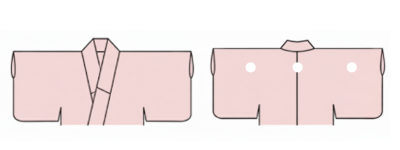
| Category | Details |
|---|---|
| Placement of Crests | Three in total: one on the center back and one on each outer sleeve (none on the chest). |
| Formality Level | Semi-formal attire (jun-reishō) — positioned between the irotomesode (five crests) and the houmongi (no crest). |
| TPO (Appropriate Occasions) | Appropriate for semi-formal events such as tea ceremonies, formal guest roles at weddings or receptions (for example, if giving a speech), and children’s school entrance or graduation ceremonies, as well as Shichi-Go-San celebrations. It can also be worn for memorial or religious ceremonies when made in subdued colors like purple, gray, or green. |
| Tips for Beginners | The mitsu-mon is an excellent balance of formality — dignified but not too solemn. It’s a versatile choice for many occasions. However, in very formal or ceremonial settings, the hito-tsu mon (one crest) version may be preferred for a slightly softer impression. |
One Crest (Hitotsu-mon)
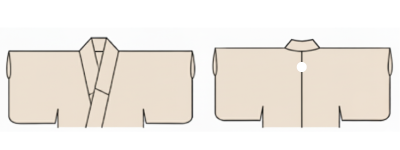
| Category | Details |
|---|---|
| Placement of Crest | One crest placed at the center of the back. |
| Formality Level | Semi-formal or informal formal attire (jun-reishō or ryaku-reishō) — comparable to a houmongi (visiting kimono), but slightly more dignified in appearance. |
| TPO (Appropriate Occasions) | The most versatile type of iromuji. Suitable for a wide range of occasions — from formal to semi-formal — such as a child’s entrance or graduation ceremony, Shichi-Go-San celebrations, shrine visits, weddings or receptions as a guest, refined tea gatherings, congratulatory parties, or dinners at an upscale restaurant. |
| Tips for Beginners | The hitotsu-mon iromuji is highly practical and elegant, ideal for first-time kimono owners. It works beautifully for events like school ceremonies or Shichi-Go-San, offering both refinement and approachability. If you’re unsure which type to choose, this one is the safest and most versatile option. |
Crestless Iromuji (Mon-nashi)

| Category | Details |
|---|---|
| Placement of Crests | None. |
| Formality Level | Casual wear (oshare-gi) — considered everyday or stylish kimono rather than formal attire. |
| TPO (Appropriate Occasions) | A crestless iromuji is treated the same as a komon or tsumugi (casual patterned kimono). It’s ideal for lunches or outings with friends, theater visits, shopping, local festivals, or strolling around town. In short, perfect for relaxed, everyday occasions. |
| Tips for Beginners | A crestless iromuji is not considered formal wear, so it’s unsuitable for ceremonial events such as school ceremonies or weddings. Instead, enjoy it as an outing kimono — pairing it with a playful obi or accessories to express your personal style. |
One Kimono, Many Transformations — Styling the Versatile Iromuji

You’ve now mastered the essentials of the iromuji — congratulations!
But the true charm of this kimono begins right here.
The beauty of the iromuji lies in its versatility.
Because it’s so simple, one single kimono can transform — almost like magic — just by changing the obi and accessories.
Maybe you’ve thought:
“I don’t want to wear it only once for the entrance ceremony.”
“How can I style it more fashionably?”
With the right coordination, the same iromuji can shift from graceful formality to elegant everyday style, revealing completely different moods each time.
In this article, you’ll find plenty of styling ideas and tips on how to mix and match your obi and accessories.
Discover how to make your iromuji a true “seven transformations” piece — not something that sleeps in your closet,
but a timeless companion for every season and occasion.
Practical Guide — How to Choose Your First Iromuji Without Regret

Now that you understand the basic rules of the iromuji,
it’s time to find the one that truly suits you.
If you’re thinking, “It’s my first iromuji—how do I choose without making a mistake?”
don’t worry.
To help you choose with confidence, here are three essential points to guide you in finding your perfect first iromuji.
Step 1: Decide Based on When and Where You’ll Wear It
The most important question is: “When do you want to wear it most?”
If your main occasions are your child’s entrance or graduation ceremony, or Shichi-Go-San celebrations,
and you also want to wear it to a friend’s wedding, then your best choice is clear.
Recommended setup:
- Crest: One crest (Hitotsu-mon)
- Fabric pattern: auspicious jimon designs such as pine, bamboo, plum blossoms, or cranes, which symbolize good fortune and dignity.
Starting your wardrobe with a formal-style iromuji bearing one crest is the smartest and most versatile choice.
It can be styled elegantly for both family ceremonies and social occasions.
(If your main purpose is lessons, tea practice, or casual outings, a crestless iromuji would be more suitable.)
Step 2: Choose Your Fabric Based on Budget and Maintenance
There are two main types of fabric for iromuji: pure silk (shōken) and synthetic fibers (kasen).
Each has its own charm and practicality — choose the one that best fits your lifestyle and how often you plan to wear it.
| Fabric | Advantages | Disadvantages | Recommended For |
|---|---|---|---|
| Silk (Shōken) | – Luxurious, soft texture with a beautiful sheen and deep colors.- Drapes gracefully and conforms naturally to the body, reducing wrinkles and keeping a neat silhouette.- Ideal for those who value quality and want to enjoy a kimono for many years. | – Sensitive to water and stains; requires professional cleaning (maruarai).- Needs careful storage and protection from humidity and insects.- More expensive compared to synthetics. | For those who appreciate high-quality craftsmanship and want a kimono that can be worn for both formal and elegant occasions. |
| Synthetic (e.g., Polyester) | – Machine-washable at home — the biggest advantage.- Durable against rain or minor stains; perfect for outings with children.- Much more affordable than silk.- Recent high-quality synthetics can even resemble silk in appearance. | – Can cause static and may feel slightly stiff against the body.- Sometimes lacks the depth and luster of silk.- Older or cheaper fabrics may look less refined. | For those who value easy care and practicality.Ideal for beginners, everyday use, or practice wear (renshū-yō). |
✨ Tip for Choosing:
If your child is still young, or if you want something easy to care for and worry less about stains,
a washable synthetic fabric is your best friend.
But if you value comfort, texture, and the timeless beauty of traditional craftsmanship,
choose pure silk — it will bring out the true elegance of kimono each time you wear it.
Step 3: The Biggest Dilemma — Which Color Should You Choose?
“Which color of iromuji will be the most versatile?”
That’s a question almost everyone struggles with.
For your first iromuji, the most practical and elegant choice is a soft, light “pale tone.”
These gentle shades — such as blush pink, cream beige, or light lavender —
work beautifully for both spring ceremonies like school entrance or graduation,
and for celebratory occasions such as a friend’s wedding.
| Color Family | Impression & Features | Recommended Scenes & Styling Tips |
|---|---|---|
| Pink Tones (light cherry blossom, salmon pink, etc.) | Brightens the complexion and creates a gentle, cheerful impression. | Perfect for spring ceremonies and celebratory occasions. Brings a soft, youthful atmosphere. |
| Cream / Beige Tones | Gentle and elegant. Extremely versatile and easy to coordinate with any obi or accessories. | Suitable for all seasons — a timeless choice when you’re unsure which color to pick. |
| Light Blue / Young Green Tones | Fresh and refined, giving a clean, intelligent impression. | Ideal for early summer or spring. Creates a light and refreshing look. |
| Lavender / Pale Purple Tones | Elegant and calm, conveying dignity and sophistication. | A color that transcends age — suitable for both formal and casual occasions. Can be worn for many years. |
💡 Note:
Deep shades such as dark purple, forest green, gray, or brown can give an elegant and composed impression.
However, depending on the obi and accessories you pair them with, they may sometimes evoke the image of mourning or memorial attire in Japan.
For your first iromuji, it’s best to choose a light, uplifting color that feels joyful and appropriate for celebratory occasions.
Iromuji Q&A — Answering the “Whys” Behind Kimono Etiquette
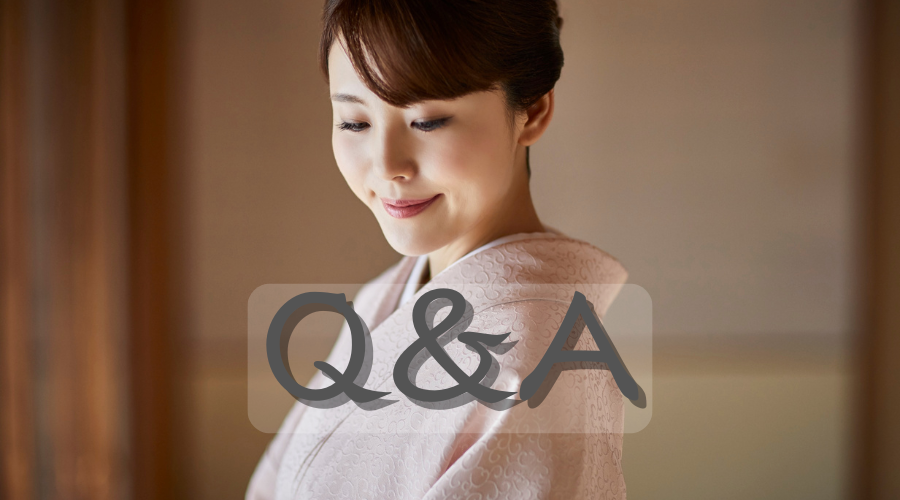
Finally, let’s clear up some of the most common questions and concerns about the iromuji —
the little “whys” that often puzzle beginners.
Here, you’ll find simple answers to help you understand how to enjoy this elegant and versatile kimono with confidence.
**Q. If it’s a plain-colored kimono, can it always be called an iromuji?**
A. Not exactly.
For example, there is a type of kimono called Edo Komon.
From a distance, it looks solid-colored, but up close you’ll notice it’s decorated with extremely fine stencil-dyed patterns.
Although an Edo Komon with one crest (hitotsu-mon) can also be worn as semi-formal attire, it’s not classified as an iromuji.
Similarly, Tsumugi (a casual woven kimono made from pre-dyed threads) can come in plain colors too,
but it’s called muji-tsumugi — a casual everyday kimono,
and is distinct from the iromuji, which is dyed after weaving and used for formal occasions.
**Q. What kind of crest (mon) is recommended for an iromuji?**
A. For events like your child’s ceremony or a friend’s wedding, a single crest (hitotsu-mon) is ideal.
As mentioned earlier, the one-crest iromuji is the most versatile option,
suitable for a wide range of semi-formal occasions.
If you prefer a slightly softer impression, instead of the most formal dyed white crest (some-nuki hinata mon),
you can choose a dyed shadow crest (kage mon) or an embroidered crest (nui mon).
It’s best to consult with a kimono specialist or shop when tailoring.
**Q. Can I rent an iromuji instead of buying one?**
A. Yes, absolutely.
If you want to wear it only once for your child’s event, or simply try it before purchasing,
kimono rental services are a convenient option.
Most stores offer full rental sets that include the iromuji, obi, nagajuban, zōri, and handbag,
often under “school ceremony” or “Shichi-Go-San” plans.
Just make sure to check whether the kimono includes one crest, depending on the formality you need.
**Q. Can I wear a lined iromuji (awase) to a wedding in June or September?**
A. Traditionally, no — but in modern practice, it can be acceptable depending on the venue.
Kimono have seasonal dressing rules known as koromogae (wardrobe change):
- Awase (lined kimono): worn from October to May
- Hitoe (unlined kimono): worn in June and September
- Usumono (sheer kimono): worn in July and August
According to tradition, wearing a lined awase kimono in June or September is considered out of season,
so an unlined (hitoe) iromuji is technically correct.
However, in modern times, air-conditioned venues such as hotels often make awase acceptable.
Still, if you’ll be taking outdoor photos, you might feel too warm —
and some people familiar with kimono etiquette may view it as slightly inappropriate for the season.
For a deeper look into kimono “koromogae” — the seasonal wardrobe change —
and how to dress beautifully through spring, summer, autumn, and winter,
you can find a detailed explanation in the article below:
👉 Related article:
Kimono Seasonal Changes| Guide to Dressing for All Four Seasons

If you’re unsure which kimono is seasonally appropriate,
the safest choice is to follow tradition and select a unlined iromuji (hitoe),
either from your own collection or through a rental service if available.
Final Thoughts: The Iromuji — A Timeless Companion When You Know Its Formality and TPO
We’ve now covered everything about the iromuji —
from what it is, to formality by number of crests, TPO, how to choose your first one, and even practical Q&A.
You might have felt that “the rules of iromuji seem complicated,”
but in truth, the two keys are simply the family crest (mon) and TPO.
To wrap up, let’s take a look at a summary chart of coordination rules by crest type —
a quick reference to help you choose the perfect iromuji for any occasion.
| Crest Type | Occasion / TPO | Obi (Belt) | Obijime (Cord) | Obiage (Scarf) | Nagajuban (Undergarment) | Zōri & Bag |
|---|---|---|---|---|---|---|
| Five Crests | Grand ceremonies, award events, weddings of close relatives | Formal fukuro obi | Wide flat cords woven with gold or silver threads | Gold or silver obijime or shibori (tie-dyed) obiage | Plain white nagajuban | Gold, silver, or white accessories |
| Three Crests | Children’s graduation or entrance ceremonies, Shichi-Go-San, miyamairi (shrine visit) | Fukuro obi | Obijime with gold threads | Soft, refined light-colored obiage | Plain white or softly toned nagajuban | Mainly gold, silver, or pale-colored accessories |
| One Crest | Friend’s wedding, children’s graduation or entrance ceremonies, tea gatherings, parties | Fukuro obi or Nagoya obi | Narrower, elegant obijime in soft colors; light or slightly deeper tones | Refined pale or softly contrasting obiage | Softly toned nagajuban | Light-colored or subtly patterned accessories |
| No Crest | Lunches or dinners with friends, theater outings, casual gatherings | Nagoya obi or hanhaba obi (half-width belt) | Free choice | Chirimen (crepe) or partially tie-dyed obiage | Free choice | Free choice |
Please use this coordination chart as a guide when choosing how to wear your iromuji for different occasions.
For mothers preparing for their children’s milestones — entrance and graduation ceremonies, Shichi-Go-San, and more — a single-crest (hitotsu-mon) iromuji will become your most dependable companion. It’s a kimono that celebrates joy and dignity, gracefully accompanying you through life’s important days for years to come.
We hope this article helps you find the perfect iromuji — a piece that feels truly your own, and one that will continue to shine beautifully in every season of your life.
